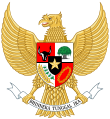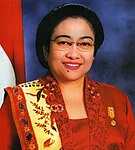1997 Indonesian legislative election
This article needs additional citations for verification. (June 2011) |
| |||||||||||||||||||||||||||||||||||||||||
425 (of 500) seats of the People's Representative Council | |||||||||||||||||||||||||||||||||||||||||
|---|---|---|---|---|---|---|---|---|---|---|---|---|---|---|---|---|---|---|---|---|---|---|---|---|---|---|---|---|---|---|---|---|---|---|---|---|---|---|---|---|---|
| Turnout | 93.6% | ||||||||||||||||||||||||||||||||||||||||
| |||||||||||||||||||||||||||||||||||||||||
| |||||||||||||||||||||||||||||||||||||||||
| This article is part of a series on the |
| Politics of Indonesia |
|---|
 |
Legislative elections were held in Indonesia on 29 May 1997. There were actually three elections in one as voters were electing members of two levels of regional government as well as the House of Representatives. This was to be the last election of President Suharto's New Order regime, which collapsed a year later. Like the preceding New Order elections, it was won outright by the Golkar organization.
Participants
Indonesian law at the time only allowed three organisations to participate in elections - the United Development Party (PPP), the Indonesian Democratic Party (PDI) and Golkar (functional group), an organisation which started off as a confederation of NGOs, and was officially not a party.
Election campaign
The 27-day campaign ran from April 27 to May 23, with a quiet period of five days before polling day.
Media coverage
The mass media tended to favour "a particular election participant",[2] for example Suara Karya newspaper only reported on Golkar campaign activities, and did not mention the PDI or PPP campaigns at all. On the other hand, the daily Media Indonesia was rather more balanced, but overall, Golkar campaign speakers received far more coverage.
In the later stages of the campaign, media coverage was dominated by reports of campaign violence. Suara Karya in particular reported three times as many violent incidents involving the PPP than any other paper.
Campaign issues
Not a single election participant started the campaign by announcing or focusing on its main themes, therefore the public really had no idea what they were offering. The campaign was dominated by "sloganistic issues" with very little substance. For example, all three election participants promised to address problems such as poverty and corruption, but none actually said how they would do this. In fact, Kristiadi says that the only difference between this campaign and the previous one in 1992 was that there was less use of verses from the Koran to try and attract support.[3]
The "Mega-Bintang Phenomenon"
Following the government's forced replacement of PDI leader Megawati Sukarnoputri by Soeryadi at the party's 1996 Medan conference, the PDI tried hard to put forward an independent image. Meanwhile, many of Megawati's supporters gravitated towards the PPP, in a phenomenon known as the "Mega-Bintang" coalition. Bintang means "star", and was the symbol of the PPP. This was an entirely unexpected occurrence. Megawati was seen as representing secular politics, while the PPP was an Islamic party, but the two found common ground as a coalition of the oppressed.
PPP officials explicitly rejected the term "coalition", and said the increase in their support was a symbol of the revival of their party. However, posters and symbols carried by Megawati supporters made it clear what the "Mega-Bintang" coalition really meant. The government then banned the use of "Mega-Bintang" posters and symbols, saying it was contrary to election regulation. This ban was used by the security forces as an excuse to remove all such symbols.
Campaign participants
According to Kristiadi, there were three types of people who took part in the campaigns:[4]
- People ordered to do so or who were after money, or who wanted to see the entertainers laid on at rallies
- People who voluntarily attended because they were proud to support their organisation
- Young people releasing energy
More than 200 people died during the course of the campaign, mostly in road traffic accidents and through being trapped in burning buildings during the disturbances in Banjarmasin.
Intimidation and other irregularities
There were reports in the press of intimidation and “buying support”, for example pressure on teachers to urge older high school students (the minimum voting age was 18) to vote for "a particular election participant" [5] with a 'reward' for compliance and 'punishment' for failure. There were also other reports of known PPP and PDI supporters being intimidated.
There were also disputes between employees, who wanted voters to cast their ballots at their places of work, and local government officials, who wanted them to vote near their homes, as each wanted to ensure they met their responsibility to achieve their quota of Golkar votes.
Results
While Golkar won 282 seats in the MPR, the PDI lost 45 (winning 56 seats) while the PPP, thanks in part to the pro-Megawati PDI wing support, won 62 seats, an increase of 27.
Votes for each election participant in each province were as follows:[6]
| Province | PPP | Golkar | PDI | |||
|---|---|---|---|---|---|---|
| Votes | % | Votes | % | Votes | % | |
| Aceh | 668,802 | 31.86% | 1,360,379 | 64.81% | 69,993 | 3.33% |
| North Sumatra | 742,958 | 12.84% | 4,648,928 | 80.33% | 395,583 | 6.84% |
| West Sumatra | 188,168 | 7.74% | 2,214,666 | 91.15% | 26,958 | 1.11% |
| Riau | 313,013 | 13.77% | 1,879,977 | 82.70% | 80,232 | 3.53% |
| Jambi | 76,964 | 5.90% | 1,208,090 | 92.58% | 19,889 | 1.52% |
| South Sumatra | 446,792 | 11.30% | 3,361,164 | 84.98% | 147,131 | 3.72% |
| Bengkulu | 30,344 | 3.85% | 747,140 | 94.77% | 10,903 | 1.38% |
| Lampung | 177,244 | 4.82% | 3,424,949 | 93.21% | 72,156 | 1.96% |
| Jakarta | 2,239,418 | 32.87% | 4,451,503 | 65.34% | 121,931 | 1.79% |
| West Java | 6,003,471 | 25.99% | 16,709,824 | 72.34% | 386,938 | 1.68% |
| Central Java | 4,961,280 | 29.01% | 11,671,667 | 68.26% | 466,840 | 2.73% |
| Yogyakarta | 602,739 | 34.22% | 1,102,256 | 62.58% | 56,487 | 3.21% |
| East Java | 6,791,399 | 33.89% | 12,620,089 | 62.97% | 630,708 | 3.15% |
| Bali | 60,779 | 3.28% | 1,727,810 | 93.21% | 65,044 | 3.51% |
| West Nusa Tenggara | 268,022 | 14.56% | 1,484,697 | 80.66% | 87,913 | 4.78% |
| East Nusa Tenggara | 29,667 | 1.51% | 1,867,339 | 94.94% | 69,880 | 3.55% |
| East Timor | 7,188 | 1.82% | 334,718 | 84.70% | 53,296 | 13.49% |
| West Kalimantan | 281,992 | 15.14% | 1,298,746 | 69.72% | 282,035 | 15.14% |
| Central Kalimantan | 95,736 | 9.83% | 843,065 | 86.60% | 34,717 | 3.57% |
| South Kalimantan | 406,719 | 25.15% | 1,164,085 | 71.98% | 46,471 | 2.87% |
| East Kalimantan | 272,961 | 23.66% | 807,678 | 70.02% | 72,902 | 6.32% |
| North Sulawesi | 42,018 | 2.44% | 1,648,075 | 95.90% | 28,521 | 1.66% |
| Central Sulawesi | 114,748 | 10.39% | 937,551 | 84.89% | 52,175 | 4.72% |
| South Sulawesi | 322,308 | 7.34% | 4,023,937 | 91.63% | 45,377 | 1.03% |
| Southeast Sulawesi | 17,498 | 2.07% | 822,163 | 97.22% | 6,033 | 0.71% |
| Maluku | 140,604 | 12.98% | 888,948 | 82.07% | 53,637 | 4.95% |
| Irian Jaya | 38,196 | 3.62% | 938,463 | 88.86% | 79,476 | 7.53% |
| TOTALS | 25,340,028 | 22.43% | 84,187,907 | 74.51% | 3,463,225 | 3.06% |
| Ballot number | Election participant | Votes | % | Seats |
|---|---|---|---|---|
| 2 | Golkar (Golongan Karya) | 84,187,907 | 74.51 | 325 |
| 1 | United Development Party (Partai Persatuan Pembangunan, PPP) | 25,340,028 | 22.43 | 89 |
| 3 | Indonesian Democratic Party (Partai Demokrasi Indonesia, PDI) | 3,463,225 | 3.06 | 11 |
| Total | 112,991,150 | 100% | 425 | |
| Source: Komisi Pemilihan Umum (General Election Commission) | ||||
Election of president
In March 1998, President Suharto was unanimously elected by the People's Consultative Assembly along with new Vice President B. J. Habibie. Due to the 1997–98 financial crisis, Suharto was forced to resign in May, just two months into his seventh five-year term.
Notes
- ^ Even though Suryadi is regarded as the chairperson of the party in 1997, the documents regarding to the general elections in 1996 was signed by Megawati. In a photograph during the drawing of ballot numbers of the general elections participants, Megawati can be seen standing alongside Harmoko and Ismail Hasan Metareum, the other two chairman.[1]
References
- ^ Pemilu Legislatif 1997
- ^ Kristiadi et al 1997, p. 84.
- ^ Kristiadi et al 1997, p. 87.
- ^ Kristiadi et al 1997, p. 109.
- ^ Kristiadi et al 1997, p. 82.
- ^ Kristiadi et al 1997, p. 161.
References
- Kristiadi, J; Legowo, T.A.; Harjanto, Budi N.T. (1997). Pemilihan Umum 1997: Perkiraan, Harapan dan Evaluasi (The 1997 General Election: Thoughts, Hopes and Evaluation) (in Indonesian). Jakarta, Indonesia: Centre for Strategic and International Studies. ISBN 979-8026-64-0.
- Schwarz, Adam (1999). A Nation in Waiting : Indonesia's Search for Stability. Allen and Unwin. ISBN 9781865081793.



